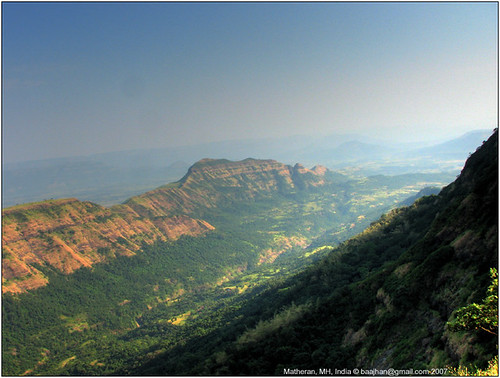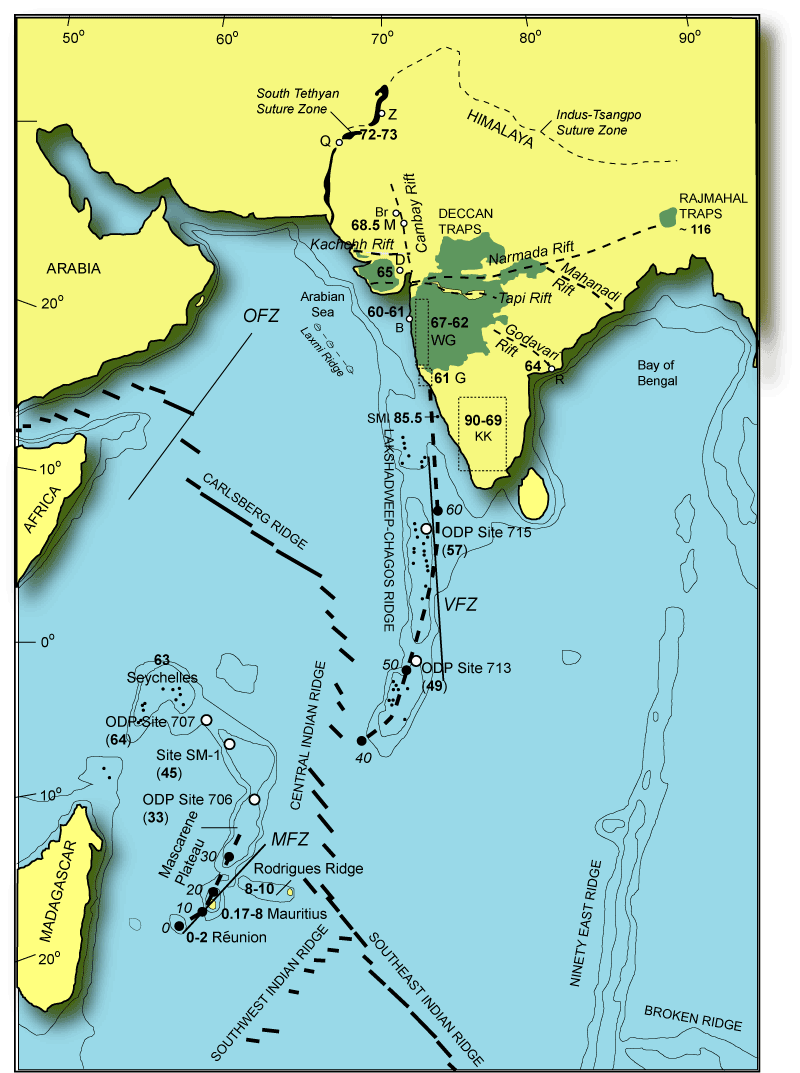HUGE FLOOD OF LAVA AT K/T BOUNDARY
CAME FROM DEEP WITHIN THE EARTH
August 13, 1993
http://www.rochester.edu/pr/releases/ear/basu3.htm
A huge outpouring of the earth's interior that occurred over much of present-day India 65 million years ago came from the boundary between the earth's lower mantle and its molten iron core some 1,800 miles beneath the surface, scientists have determined. The work is published in today's issue of Science.
By measuring the oldest samples of helium ever obtained -- helium trapped in rocks 68.5 million years old -- scientists at the University of Rochester and the Institute of Human Origins in Berkeley, Ca. show that volcanic activity incubated for 3.5 million years before erupting, rapidly blanketing the Indian subcontinent with more than 1 million cubic kilometers of lava. The stack of lava is now known as the Deccan Traps.
Scientists have long debated the source of such huge outpourings of lava, known as flood basalt volcanism. Some scientists believe that such volcanoes begin within the earth's upper mantle or lithosphere just beneath the crust, while others believe they begin 1,800 miles beneath the surface at the base of the lower mantle. The Science paper gives some of the most compelling evidence yet that such volcanism begins as a plume, a long column of gas-bearing rock, within the lower mantle near the earth's core. Asish R. Basu and Robert J. Poreda of the University of Rochester and Paul R. Renne of the Institute of Human Origins in Berkeley, Ca., believe that other flood basalts, such as ones that covered Siberia, parts of Brazil, the Karoo Province in southern Africa, and the northwestern United States, also have a plume origin.
Such outpourings of lava often coincide with the biggest extinctions in earth history. This paper gives the most precise date yet for the end of the main pulse of Deccan volcanism -- 64.9 million years ago, give or take 100,000 years -- and shows that it occurred precisely at the time between two geologic time periods, known as the Cretaceous and Tertiary periods (the K/T boundary), when dinosaurs and many other animals became extinct. Two years ago in another Science paper, Renne and Basu showed that the extensive volcanism in Siberia 248 million years ago occurred at precisely the time of the largest extinction in earth's history.
"This paper's primary importance is on how flood basalts form and how they evolve," says Renne, who notes nevertheless that "the results will be interpreted in different ways by different people" seeking to explain the demise of the dinosaurs. "No definite link between the Deccan volcanic activity and the disappearance of the dinosaurs has been proven," he notes.
Isotopic measurements show that the lava originated at the boundary between the earth's lower mantle and the molten outer core. Super-hot, buoyant rock pushed upwards and rose in a narrow column like a plume hundreds of miles to the earth's crust.
"As the plume rises in the mantle as a narrow column, it becomes less compressed, begins to melt and gets bigger," says Basu. "When it approaches the earth's crust it continues to build, like a giant mushroom with a long tail. Finally it breaks through the crust, and vast floods of lava occur." Such lava flows, known as flood basalts, are the biggest outpourings of the earth's interior the world has ever seen. The Deccan eruption alone would have covered the entire surface of the Earth with a lava layer 10 feet thick if it had spread evenly over the continents and oceans.
To determine the origin of the Deccan Traps, Basu and colleagues analyzed the ratio of certain isotopes of helium and strontium in rocks brought up during volcanic activity. Several rocks dating from 68.5 million years ago, 3.5 million years before the main eruption, have the "isotopic signature" characteristic of the lower mantle. "This shows that the mantle beneath India was melting millions of years before the bulk of the eruption occurred," says Basu.
The same lower mantle signature also typifies several "hot spots," volcanic areas beneath earth's plates responsible for forming chains of volcanoes as the plate gradually slides above. Reunion Island in the Indian Ocean is thought to be the hot spot that formed the Deccan Traps. Other hot spots with a lower mantle source are believed to have formed Hawaii and Iceland.
Basu carefully combed India for just the right rocks, looking for samples that had held their helium since the time of the dinosaurs. He found intact helium samples inside bubbles of carbon dioxide encapsulated within one-millimeter grains of the mineral pyroxene. Basu chose samples from the "early froth" of the plume, which were carried upward virtually intact, were not contaminated by melting, and which never made it to the surface to release their helium. Helium isotopic composition was measured by Poreda, associate professor of geology at Rochester.
"The high helium-3 to helium-4 ratio points to a lower mantle source for the Deccan flood basalts," says Poreda. "The helium-3 is a remnant from the formation of the earth 4.5 billion years ago; such high ratios are found only in plumes from the lower mantle."
Renne dated the rocks that contained the helium using the argon-argon laser heating technique applied to individual grains of the minerals biotite and hornblende. With this technique, one of the most precise available, researchers determine how old a rock is by determining how much argon has been produced by the radioactive decay of potassium in that rock.
Working on the project besides Basu, Renne and Poreda were graduate student Friedrich Teichmann at Rochester and Deb DasGupta of Presidency College in Calcutta, India. The work was supported by the National Science Foundation and the Institute of Human Origins.
++++++++++
http://www.wired.com/wiredscience/2008/12/deccantraps/
 SAN FRANCISCO — Huge volcanic eruptions that belched sulfur into the air for around 10,000 years could have killed the dinosaurs, according to new evidence unearthed by geologists.
SAN FRANCISCO — Huge volcanic eruptions that belched sulfur into the air for around 10,000 years could have killed the dinosaurs, according to new evidence unearthed by geologists.
Evidence is accumulating that it wasn’t an asteroid that did the beasts in, but volcanoes — the first real challenge the extinction theory has met in three decades.
A combination of studies on dinosaur fossils, magnetic signatures in rocks and the timing of the disappearance of different species suggest it was volcanoes, not an asteroid, that caused the dinosaurs’ extinction.
"We’re discovering … amazingly large flows, amazingly short time scales and amazing volcanic (eruptions)," said Vincent Courtillot of the University of Paris, who is is presenting new evidence for the volcano theory this week at the American Geophysical Union conference here.
For the last 30 years, the prevailing theory has been that an asteroid, around six miles across, hit the Yucatan peninsula 65 million years ago, throwing debris into the atmosphere, blocking the sun and chilling the planet to the point that nearly half of all species went extinct.
Physicist Luis Alvarez of the University of California, Berkeley, first presented the asteroid impact hypothesis in 1980. It was based on an extensive layer of iridium, which is associated with impacts, that could be found in many places across the globe in the same geologic time sequence. A decade later, the Chicxulub crater was discovered on the Yucatan peninsula, adding weight to the idea that an impact killed off the dinosaurs.
The idea that Indian volcanoes, known as the Deccan Traps, might have contributed to the mass extinction is not new. But scientists at the AGU meeting think the eruptions could be the sole cause of the die-offs, and that the asteroid had little or no effect on life at all.
"If there had been no impact, we think there would have been a massive extinction anyway," Courtillot said.
Courtillot has studied the magnetic signatures of the Indian volcanic deposits that lined up with the Earth’s magnetic field as they cooled. Because the orientation of the magnetic field has changed over time, lava that cooled at different times have different signatures.
The more than 2-mile thick pile of Deccan Traps deposits has several major pulses that occurred over the course of several decades each, almost certainly less than 100 years. And the entire sequence erupted in less than 10,000 years, rather than the million years or more that has been suggested.
All told, this would have put 10 times more climate-changing emissions into the atmosphere than the asteroid impact.
Also supporting the volcanic theory is fossil evidence from Texas and Mexico that most of the species extinctions coincided with the final pulse of eruptions, not with the asteroid impact, which may have occurred approximately 300,000 years earlier, according to Gerta Keller of Princeton University.
"There is essentially no extinction associated with the impact," Keller said.
Evidence that dinosaurs survived in India right up to the final volcanic onslaught further bolsters the case.
But it will take a lot of evidence to convince the bulk of the scientific community that the asteroid theory is wrong.
"There was volcanism at the time. There’s always volcanism, but that impact is so significant that you can’t ignore it," said Rick Firestone of Lawrence Berkeley National Laboratory who studies the link between impacts and extinctions. "The only question is, were there other things that happened as result of it."
++++++++++






